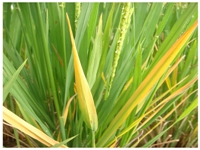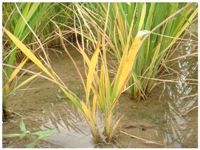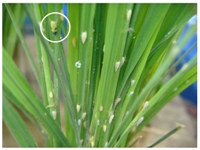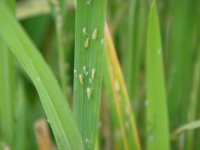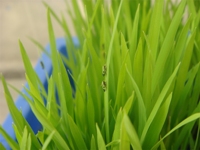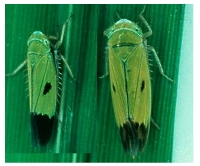| Management Strategies : |
|
Cultural Methods:
- The most effective means of GLH management is to use GLH-resistant and tungro-resistant varieties like IR 50, IR 54, IR 64, CR 1009, PY 3, Co 46 and white ponni .
- Apply neem cake @ 12.5 kg/20 cent nursery as basal dose.
- Transplanting older seedlings (>3 weeks) reduces viral disease susceptibility transmitted by leafhoppers.
- Nitrogen should be applied as needed to avoid contributing to population or hindering plant recovery from plant hopper damage by applying insufficient nitrogen.
- Good weed control in the field and on the bunds removes the preferred grassy hosts of Green leaf hopper and promotes crop vigor.
- Crop rotation with a non-rice crop during the dry season decreases alternate hosts for diseases.
- Upland rice intercropped with soybean reduces the incidence of leafhoppers on rice compared to rice alone
|
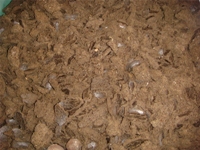 |
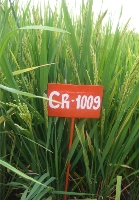 |
| Apply neem cake to nursery |
Use resistant variety - CR 1009 |
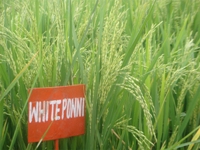 |
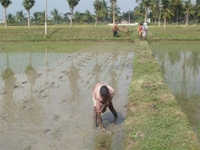 |
| Use resistant varieties - White ponni |
Weed control on field and bunds |
|
Chemical Methods:
- ETL : 60/25 net sweeps (or) 5/hill at vegetative stage (or) 10/hill at flowering (or) 2/hill in tungro endemic area
- Scout the field for the presence of Tungro and Green leaf hopper. Check 20 hills while walking diagonally across a transplanted field.
- Spray insecticides twice, 15 and 30 days after transplanting.
- Spray any one of the following:
Fenitrothion 50 EC 80 ml (or) Phosphamidon 40 SL 50 ml (or) Fenthion 100 EC 40 ml (or) Quinalphos 25 EC 80 ml (or) Phosalone 35 EC 120 ml (or)Monocrotophos 36 SL 40 ml.
- Maintain 2.5 cm of water in the nursery and broadcast anyone of the following in 20 cents Carbofuran 3 G 3.5 kg (or) Phorate 10 G 1.0 kg (or) Quinalphos 5 G 2.0 kg
|
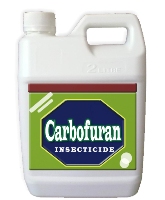 |
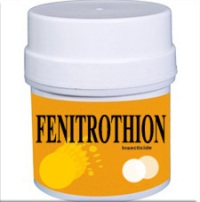 |
| Spray Chlorpyriphos |
Spray Phosphamidon |
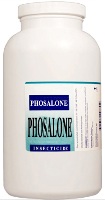 |
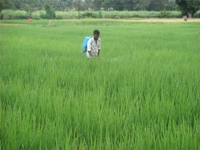 |
| Spray Quinalphos |
Spraying of Insecticide |
|
Biological Methods:
- The major egg parasitoids are:
• Oligosita yasumatsui (Hymenoptera: Trichogrammatidae).
• Anagrus spp. (Hymenoptera: Mymaridae).
• Gonatocerus spp. (Hymenoptera: Mymaridae).
- The most abundant predator is the green mired bug Cyrtorhinus lividipennis which predate on both eggs and nymphs.
- Strepsipterans, small wasps, pipunculid flies, and nematodes parasitize both the nymphs and adults.
- They are also attacked by aquatic veliid bugs, nabid bugs, empid flies, damselflies, dragonflies, and spiders. A fungal pathogen infects both the nymphs and adults of the green leafhopper.
|
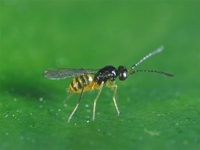 |
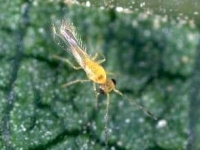 |
| BioControl Wasp - Gonatocerus spp |
Egg parasitoid -
anagrus spp. |
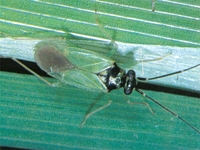 |
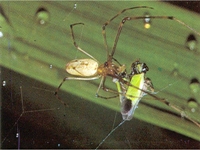 |
| Predator - Cyrtorhinus Lividipennis |
Spider Predator -
Argiope Catenulata |
|
Natural enemies and predators:
Natural enemies :
- Itoplectis narangae - Ichnuemonidae Wasp
- Trichomma cnaphalocrocis - Ichnuemonidae Wasp
Predators :
- Release of mirid bug Cytorhinus lividipennis @ 50 – 75 egg/ m2
|
 |
 |
| Natural Enemy - Trichomma cnaphalocrocis |
Predator - Micraspis crocea |
|
Trap Methods:
- Set up light traps to attract and kill the moths. Set up light trap one for at least 5 ha.
- Set up bird perches (40 to 50/ha) of Insectivorous Birds at vegetative phase of crop.
- Monitor through phermone traps (@ 10 to 12/ha for timely control measures. Change the lure at 15-20 days intervals.
|
 |
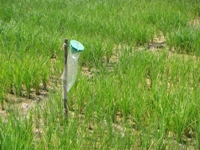 |
| Set up light trap |
Use pheromone traps |
| Top |
